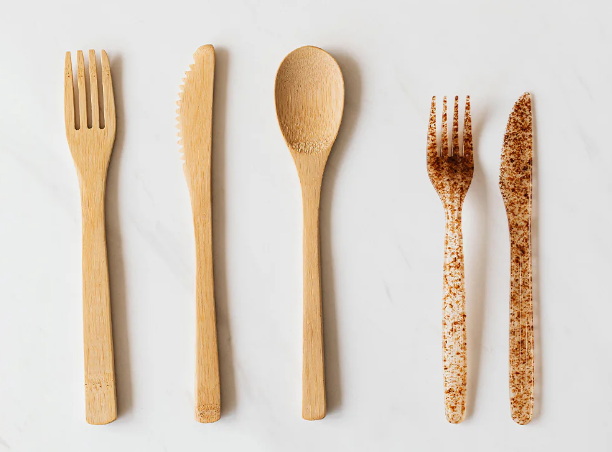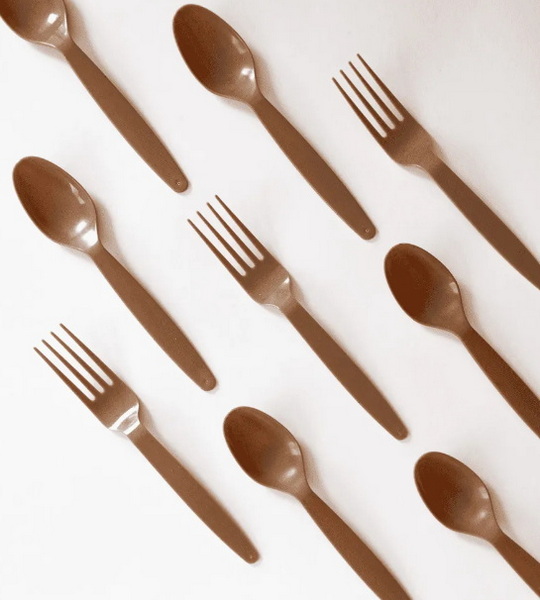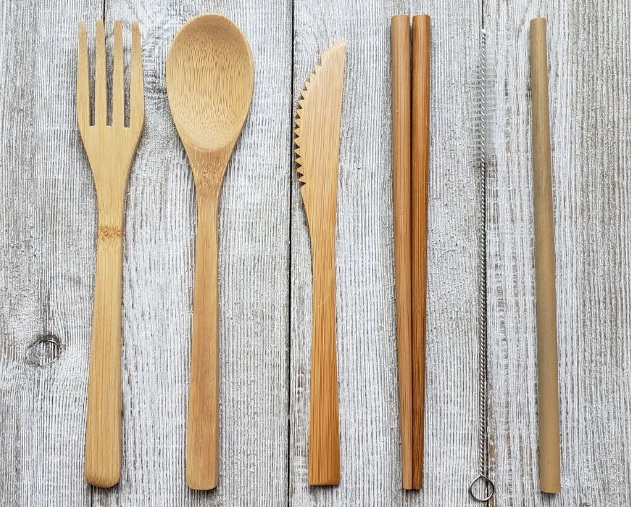
Content Menu
● Introduction to Compostable Cutlery
● Environmental Benefits
>> Reduced Carbon Footprint
>> Decreased Dependency on Fossil Fuels
>> Enhanced Waste Management
● Types of Compostable Cutlery
>> Bioplastic Cutlery
>> Bamboo and Palm Leaf Cutlery
>> Wooden Cutlery
● Challenges and Limitations
● Promoting Sustainable Practices
● Case Studies and Innovations
>> Denmark's Transition to Wooden Cutlery
>> Sugarcane Bagasse Cutlery in India
>> Technological Advancements
● Economic and Social Impact
● Consumer Education and Awareness
● Conclusion
● FAQs
>> 1. What is Compostable Cutlery?
>> 2. How Does Compostable Cutlery Reduce Plastic Pollution?
>> 3. What Are the Challenges of Using Compostable Cutlery?
>> 4. Is Compostable Cutlery Healthier Than Traditional Plastic?
>> 5. Can All Types of Compostable Cutlery Be Composted at Home?
● Citations:
In recent years, the world has witnessed a significant shift towards sustainable living, with a particular focus on reducing plastic waste. One of the key areas of innovation is in disposable cutlery, where environmentally friendly disposable cutlery has emerged as a promising alternative to traditional plastic utensils. Compostable cutlery, made from materials like cornstarch, bamboo, or sugarcane, is designed to break down naturally, reducing the environmental impact of single-use plastics. But is this new wave of cutlery truly environmentally friendly? Let's delve into the details.

Introduction to Compostable Cutlery
Compostable cutlery is made from renewable resources such as cornstarch, sugarcane, or bamboo. These materials are biodegradable and can decompose into organic matter, water, and carbon dioxide under controlled composting conditions, leaving no toxic residues behind. This process not only reduces plastic waste but also supports a circular economy by turning waste into valuable resources.
Environmental Benefits
Reduced Carbon Footprint
The production of compostable cutlery from renewable resources significantly lowers greenhouse gas emissions compared to traditional plastic manufacturing, which relies on fossil fuels. Plants absorb CO2 as they grow, further reducing the carbon footprint of bioplastics[1][2].
Decreased Dependency on Fossil Fuels
By using renewable resources, compostable cutlery reduces our reliance on finite fossil resources, promoting a more sustainable production model[1][2].
Enhanced Waste Management
Compostable cutlery provides a solution to the growing problem of plastic waste by turning into compost, thus supporting the waste management ecosystem and reducing landfill waste[1][3].
Types of Compostable Cutlery
Bioplastic Cutlery
Made from materials like cornstarch or sugarcane, bioplastic cutlery is compostable in industrial facilities. However, it often requires specific conditions to decompose effectively and may not be widely accepted by all composting facilities[1][2].
Bamboo and Palm Leaf Cutlery
These are made from natural, renewable materials and can be composted at home or in industrial facilities. They are durable but may not be as strong as plastic for cutting tough foods.
Wooden Cutlery
Wooden cutlery is compostable and can be broken down in both home and industrial composting environments. It is a natural, non-toxic option but may take longer to decompose than bioplastics[4].
Challenges and Limitations
Despite the environmental benefits, compostable cutlery faces several challenges:
- Durability and Cost: Compostable cutlery is often less durable than plastic and more expensive, which can be a barrier for widespread adoption[3][7].
- Availability of Composting Facilities: Not all regions have access to industrial composting facilities, which are necessary for bioplastic decomposition[3].
- Consumer Awareness: There is a need for greater consumer awareness about the proper disposal and benefits of compostable cutlery[3].

Promoting Sustainable Practices
To fully leverage the benefits of compostable cutlery, it's essential to promote sustainable practices:
- Encourage Sustainable Agriculture: By choosing products made from renewable resources, consumers support sustainable farming practices[2].
- Support Circular Economies: Compostable cutlery helps create a closed loop where waste is turned into valuable resources, minimizing waste and supporting nutrient cycling[8].
Case Studies and Innovations
Denmark's Transition to Wooden Cutlery
Denmark is making significant strides towards sustainability by increasing the use of wooden cutlery as part of its goal to become plastic-free by 2030. Restaurants in Denmark are transitioning to wooden alternatives, and there has been a notable reduction in plastic waste[4].
Sugarcane Bagasse Cutlery in India
In India, sugarcane bagasse cutlery is gaining popularity as a sustainable alternative. This type of cutlery not only reduces plastic waste but also supports local agriculture by utilizing sugarcane waste[8].
Technological Advancements
Manufacturers are actively seeking innovative production processes to lower costs and improve the performance of compostable cutlery. This includes developing new materials and enhancing manufacturing techniques to ensure that compostable tableware performs well in various dining scenarios[7].
Economic and Social Impact
The shift towards compostable cutlery also has economic and social implications:
- Job Creation: The production of compostable cutlery can create jobs in sustainable agriculture and manufacturing sectors.
- Market Growth: As demand for sustainable products increases, the market for compostable cutlery is expected to grow, driving innovation and reducing costs over time[7].
Consumer Education and Awareness
Educating consumers about the benefits and proper disposal of compostable cutlery is crucial for maximizing its environmental impact. This includes understanding the difference between biodegradable and compostable materials and ensuring that these products are disposed of in appropriate composting facilities[3].
Conclusion
Compostable cutlery offers a promising solution to the environmental challenges posed by traditional plastic utensils. While it presents several benefits, including reduced carbon footprint and enhanced waste management, it also faces challenges related to durability, cost, and availability of composting facilities. As consumers become more aware of the importance of sustainable living, the demand for environmentally friendly disposable cutlery is likely to grow, driving innovation and improvement in this sector.

FAQs
1. What is Compostable Cutlery?
Compostable cutlery is made from renewable materials like cornstarch, bamboo, or sugarcane, designed to break down into organic matter in composting environments.
2. How Does Compostable Cutlery Reduce Plastic Pollution?
Compostable cutlery reduces plastic pollution by decomposing naturally, thus avoiding the accumulation of plastic waste in landfills and oceans.
3. What Are the Challenges of Using Compostable Cutlery?
Challenges include higher costs, less durability compared to plastic, and limited availability of composting facilities in some areas.
4. Is Compostable Cutlery Healthier Than Traditional Plastic?
Yes, compostable cutlery is healthier as it does not contain harmful chemicals like BPA or phthalates found in some plastics[2][5].
5. Can All Types of Compostable Cutlery Be Composted at Home?
Not all types; bioplastic cutlery typically requires industrial composting facilities, while wooden or bamboo cutlery can often be composted at home[4].
Citations:
[1] https://greentekplanet.com/understanding-how-bioplastic-plant-based-cutlery-is-compostable-a-sustainable-choice-for-the-planet/
[2] https://drbio.in/compostable-cutlery-made-from-corn-starch/
[3] https://cosmosecofriends.com/biodegradable-cutlery-the-sustainable-choice-for-a-greener-tomorrow/
[4] https://whatisgreenliving.com/best-eco-friendly-disposable-cutlery/
[5] https://refork.com/news/plastic-cutlery-vs-biodegradable-alternatives/
[6] https://www.ecobifrost.com/advantages-of-using-biodegradable-disposable-cutlery/
[7] https://www.mviecopack.com/news/what-challenges-and-breakthroughs-will-compostable-food-tableware-face/
[8] https://www.quitplastic.in/post/revolutionizing-sustainability-the-rise-of-biodegradable-and-compostable-cutlery
[9] https://ecolunchboxes.com/blogs/news/when-compostable-is-sometimes-worse-than-plastic
[10] https://www.linkedin.com/pulse/benefits-biodegradable-disposable-cutlery-source-one-eco
[11] https://www.kimecopak.ca/blogs/news/consumer-attitudes-towards-eco-friendly-cutlery
[12] https://closedloop.com.au/sustainability-blog/should-i-buy-biodegradable-cutlery/
[13] https://bioplasticsnews.com/2020/01/09/compostable-wooden-cutlery-worse-environment/
[14] https://westshorecutlery.com/disposable-wooden-cutlery/
[15] https://chuk.in/the-journey-of-chuk-from-an-idea-to-a-sustainable-business-model/
[16] https://westshorecutlery.com/biodegradable-disposable-cutlery/
[17] https://www.anchenggy.com/blog/the-ultimate-guide-to-biodegradable-disposable-cutlery.html
[18] https://www.allianceonline.ie/blog/2023/03/why-biodegradable-disposable-cutlery-is-a-better-choice/
[19] https://www.circlepac.com/blogs/articles/challenges-and-solutions-in-biodegradable-packaging-manufacturing

















